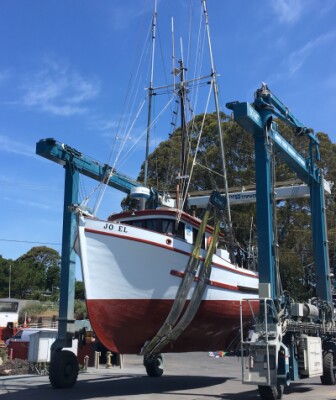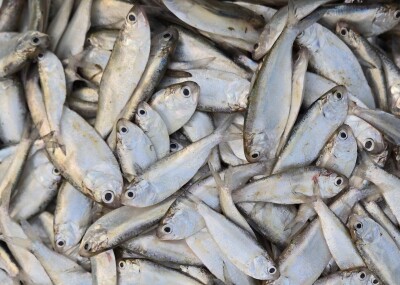ATY North
Drought is over at Maine boatshop; lobster boat racer doubles his power
It's been several years since the Red Baron from Holland's Boat Shop in Belfast, Maine, has idled up to the starting line of a Maine lobster boat race. This summer was going to be different; Glenn Holland had planned on bringing the Baron into the shop to prepare the 32 footer for the 2014 racing season, but it was not to be.
"There was just no way, we was just so damn busy," Holland says. That's after a period of limited boatbuilding activity. "A drought," is how Holland refers to it: "It's about time we got a little rain."
On the shop floor are four 32' x 10' 6" Holland hulls. A 38' x 12' 10" Holland was just delivered, and a couple more 38s are in the works. The 38-footer went out the door as a kit boat with a hull and deck to Farrin's Boatshop in Walpole, Maine, to be finished off as a lobster boat for David Hupper in Tenant's Harbor.
Holland says Hupper is one four brothers: "He'll be the third brother that has one of my 38s."
One of the 32s with a 300-hp Cummins will be finished off at Holland's Boat Shop. She's going to Scott Simpson, a lobsterman in Wiscasset. Another 32 will be launched in May as a tuna boat for Chris Peterson in Freeport. The remaining 32s are for pleasure boat owners.
Another project has a 38-footer being stretched to 41 feet, and is being set up as a lobster boat for Gerry Cushman in Port Clyde. Behind this one is another kit boat going to Freeport.
Holland figures business has picked up because pleasure boat owners, especially, "are sick and tired of waiting. They said, 'the hell with the economy. I'm not getting any younger. I'm going buy my damn boat.' Fishermen are making a little money, so they are beginning to spend a little."
While he's building the current crop of boats, Holland says he's already thinking of getting the Baron in the water for the 2015 racing season. If that happens, then his grandson, Gavin Holland, will be at the wheel, the forth Holland generation to be racing.
"No other family has had four generations racing," Holland says. "There's plenty of Alleys and Beals, but not all from the same family — all from the same tree but different branches."
Another Maine shop with a racing background that may have to forgo the coming racing season is C&C Machine in Ellsworth. C&C Machine's Glenn Crawford has been racing the 28-foot Wild, Wild West with an International DT466 for power. West described the engine as "a diesel on steroids" with a blower, two turbos, an oversized injector pump, water injection and nitrous oxide.
All that and more went into the inline 6-cylinder International to boost the power from a stock horsepower rating of 190-210 to about 450 horsepower and 46.7 mph. But the International couldn't handle the infusion of Crawford's steroids package.
"It wasn't capable of taking the punishment we were putting to it. It went like hell, but we were constantly fixing things. I knew it was a grenade every time we took it out, but it still was a lot of fun," he says.
The demise of the International was never in doubt once Crawford acquired a used V12 Isotta Fraschini 1312. "That's a 20-liter engine and 1,050 horsepower," Crawford says.
The International has been pulled from the Wild, Wild West, and the Isotta sits on blocks, straddling the keel with the old shaft cut out of the boat. The Italian engine has two turbos, but beyond that Crawford doesn't expect to add any of the usual high-power goodies you might see in a racing lobster boat.
"We're going in the opposite direction," Crawford says. "We've always gone with something that's modified, wild and crazy. This will be a stock engine. Hit the key and hope we go like a streak of shit and have a lot of fun."
It's hard to break old habits, so only time will tell if the Isotta remains stock. In the meantime, get ready for the lobster boat racing season, which begins June 14 at Boothbay Harbor, followed the next day with races at Rockland Harbor. — Michael Crowley
ATY West
Boatbuilder says rules are a job killer; Calif. boat carpenter caters to wood
In Homer, Alaska, Freddy's Marine delivered a couple of fiberglass 33' x 10' 10" bowpickers for Prince William Sound, and is building a 32' x 14' bowpicker for Bristol Bay. Add to that list a 58-footer similar to the Sea Prince that was launched last year.
The 58' x 20' seiner and longliner is for Gus Linville of Seward and should be leaving the boatyard by the end of June.
Both the Sea Prince and Linville's boat are based on an older design called the Seaworthy Marine hull that the boatyard lengthened and widened. Linville's boat differs somewhat from the Sea Prince. Its sheer from amidships to the stern was raised 6 inches, and the wheelhouse "is smaller, and the front doesn't have the wraparound" look, says the boatyard's Freddy Martushev.
Linville boat will have a John Deere main engine and a couple of generators. Because the seiner's keel was built before July 1, 2013, the boat doesn't fall under the new regulation in the Coast Guard Authorization Act of 2010 that requires boats 50 feet and over to be classed.
That means dealing with classification societies, and that jacks up a boat's designing and building costs, which is causing Martushev to see a dark shadow looming over his future, as well as the future of others in the boatbuilding business.
"Hopefully [the regulations] will be thrown away," Martushev says. "It's hurting not only my business but the marine trades of Homer. All the hydraulic shops, boatbuilding supplies, hardware stores have been affected."
Martushev says a boat brings "$1.5 million to the town." And with the new regulations, he expects a lot fewer new boats.
Part of the frustration for Martushev is that classification societies aren't providing any guidance.
"There is no rules," he says. Martushev called the Seattle office of the classification society Det Norske Veritas, or DNV, and asked about guidelines to build a 58-footer.
The answer he got was "I don't know." That, says Martushev, is "very frustrating. They aren't trying to create jobs. They are trying to take them away."
At the moment, David Peterson doesn't have to worry about the Coast Guard Authorization Act of 2010. Operating out of boatyards around Eureka, Calif., Peterson specializes in repairing and rebuilding older wooden commercial fishing boats.
One of the boats he's been working on is the Supreme, a 48-foot tuna troller built in 1946 in Tacoma, Wash., that was in a collision.
He had to replace numerous planks on both sides of the hull, and then he completely refastened and recaulked the bottom. He put fifteen new frames into the boat and replaced part of the bulwarks. He also installed a new covering board and replaced all the stub frames in the well deck.
"The collision loosened a lot of stuff up," Peterson says. "Some stuff just needed the work, but I did a lot of stuff to stiffen it up." The wood that went into the boat is Alaskan yellow cedar.
One of the bigger jobs he's undertaken is the 50-foot Viking (ex-Seamate), a tuna, crab and salmon boat. This is another boat built in 1946, only she came out of Bryant's Marina in Seattle.
The Ed Monk-designed Viking was hauled at Z&Z Boatyard in Eureka, so Peterson could refasten the bottom. Then it went back into the water to have the rest of the work done at the dock.
"I took everything off the boat that was decayed, including a good portion of the stern, all of the forward bulwarks and quite a bit of planking from the guard up," says Peterson. "It's pretty bare now but will be one of the top boats on the coast when we get done."
Next in line is the 47-foot crabber and troller Calypso to have the bottom refastened and recaulked. That's after Peterson puts a new stern on the 45-foot plywood troller Persistence that was stove up when she was rammed in Fort Bragg by the Black Hawk.
— Michael Crowley
ATY South
College president takes up oystering; Canadian 45-footer goes to Virginia
During the Rec
onstruction Era (1865-1877), doctors, lawyers, ministers, educators and businessmen, closed their doors and paddled out on Virginia's tributaries in any makeshift skiff available to hand-tong for oysters, the best opportunity to bring home real money.
Virginia's economy is not that horrible today, but the comeback of Chesapeake Bay's oyster fishery is causing some interesting happenings. Perhaps the most exciting is that many older wooden boats are being brought back to life and going to work.
Dr. Elizabeth Crowther, president of Rappahannock Community College in Glenns, Va., and a partner recently purchased a wooden deadrise boat built with a round stern by the late H.M. Stevens. The Last Chance, with a 4-53 Detroit Diesel for power, is rigged up to dredge for oysters on private oyster grounds that Crowther leases from the state.
The Last Chance is on the rails at Reedville Marine Railway in Reedville, Va. It is being surveyed by Donald McCann of Tranquil Waters Marine Services and will be repaired by Frank Fife and Taylor Dawson, two journeymen boat carpenters.
George Butler owner of the railway, allows Fife and Dawson, who used to work for him, to do repair boats on his railway. He also has an arrangement where watermen can repair their own boats.
The 42-footer needs some new side planking, bottom planking and repairs to a chine log, says Butler. The staved round stern is unusual for that area. Most round-stern boats on Virginia's Northern Neck were built out of chunks. The chunk stern was made from layered blocks of wood placed so the seams of one layer don't line up with the seams in another layer. In contrast, a staved stern has a bottom and top rim with staves nailed vertically to close in the stern area.
Butler is not doing the repair work on the Last Chance, because he and his son, Wesley are busy building a new 25-foot deadrise skiff with a center console for a recreational fisherman. Butler is laying off the lines for the 25-footer. "I build my boats by eye, but this owner wants a flatter deadrise than normal with tumblehome built into the sides, which I have never put into my boats," he says. "I'm having some trouble laying it off, but I think it's coming my way."
Moving down to the Nansemond River, a tributary of the James River, Ben Johnson of Johnson & Sons Seafood in Suffolk, Va., opted to have the company's new boat built not by a Southern builder but by Provincial Boat & Marine on Canada's Prince Edward Island.
The fiberglass Provincial 45 was delivered by truck in January to Crisfield, Md., and then Johnson ran the boat home across Chesapeake Bay. The Christianna J. is a 44' 11" x 14' 6" x 3' 9" oyster and crab boat that will be dredging for market and seed oysters, and crabbing for blue crabs in the Nansemond and James rivers.
A 600-hp Cummins QSC 8.3 diesel powers the Christianna J. The Cummins works through a ZF304 marine gear with 2.55:1 reduction that turns a 32" x 28", five-blade prop on a 2.5-inch shaft.
The Cummins engine is under the deck, which eliminates an engine box. "We needed wide open space from the back of the house to the transom, and not having an engine box gives us 26 feet of open space," Johnson says.
There is hydraulic steering with duel helmsmen stations. Electronics include Furuno radar, GPS, plotter and sounder; there's also a Simrad autopilot and two Standard Horizon VHF radios.
The Christianna J. is built with a removal transom allowing Johnson to plant seed oysters by blowing them out the open stern with a high-pressure water hose. He'll plant between 400 and 500 bushels of seed oysters.
Two people can remove the transom from the channels in the stern it slides into. "In a matter of minutes, it is up and out of the way, and we've got wide open space," says Johnson.
— Larry Chowning






